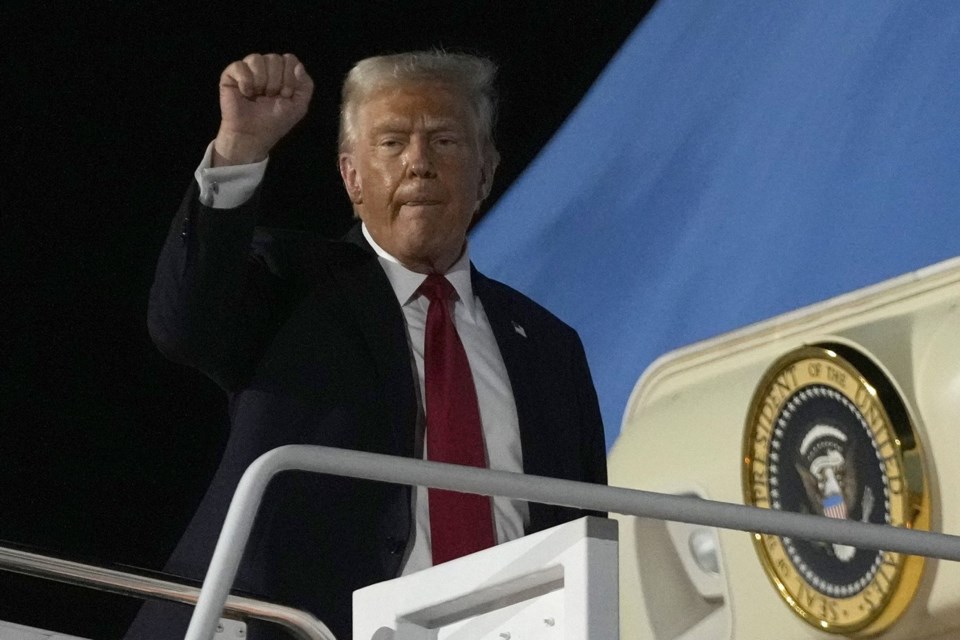WASHINGTON — Donald Trump has signed executive orders to slap 25 per cent tariffs on all steel and aluminum imports into the United States, including Canadian products, starting March 4 — the same deadline given to Canada to convince the U.S. president to halt his plan for across-the-board duties.
"It's a big deal. This is the beginning of making America rich again," Trump said as he signed the executive orders in the Oval Office.
The orders remove the exceptions and exemptions from Trump's 2018 tariffs on steel, which excluded Canada and other countries from the duties. Monday's orders also increased aluminum tariffs to 25 per cent from 10 per cent, which was what he'd set them at in 2018.
In a post on X Monday evening, Industry Minister François-Philippe Champagne said steel and aluminum tariffs on Canada would be "totally unjustified."
"Canadian steel and aluminum support key industries in the U.S. from defence, shipbuilding, energy to automotive," Champagne said.
The minister said the government is consulting with its international partners, adding that its response will be "clear and calibrated."
"We will continue to stand up for Canada, support our workers, and defend our industries as we have always done and always will," he said.
Monday's move marks another escalation in Trump's rapidly changing geopolitical agenda that's charting America on a new course for foreign policy and trade. The president also suggested he would also announce "reciprocal tariffs" later this week.
It's all happening one week after Trump temporarily paused plans to slap Canada and Mexico with 25 per cent across-the-board tariffs and a lower 10 per cent levy on Canadian energy.
Trump delayed those levies until at least March 4 in response to border security commitments from both countries, saying it would allow time to reach a "final economic deal."
Some experts say Trump's tariffs are likely a first step in his plan to rattle the Canada-U.S.-Mexico Agreement ahead of a mandatory review in 2026.
Trump did not offer much relief on Monday for Canadians hoping the delay would allow for a deal ending the tariff threat for good. Trump said America has been "pummeled by both friend and foe alike" and duties would bring manufacturing back to the United States.
"If we make it in the United States, we don't need it to be made in Canada," Trump said. "We have the jobs. That's why Canada should be the 51st state."
Canadian premiers are travelling to Washington this week on a joint mission to meet with Republicans lawmakers and attempt to sway the president away from the threatened duties.
Ontario Progressive Conservative Leader Doug Ford said he spoke with the CEOs of Stelco and Dofasco, prominent Canadian steel companies, about the looming tariffs Monday morning. Ford used Trump's tariff threats as justification for calling a snap provincial election.
He said Ontario is prepared to react "hard" and "fast."
In a media statement, Alberta Premier Danielle Smith cited the fact that the initial tariff threat was paused as "further evidence that diplomacy and action on border security matters."
While Trump's rhetoric about American expansion is sending shock waves around the world, Monday's tariffs harken back to similar actions taken under his first administration.
During negotiations on the Canada-U.S.-Mexico Agreement, commonly dubbed "the new NAFTA," Trump floated the idea of a 25 per cent tariff on the Canadian auto sector; it was never implemented.
He did use his national security powers to impose a 25 per cent tariff on steel imports and a 10 per cent tariff on aluminum imports in March 2018.
The day after announcing those levies, Trump posted on social media that "trade wars are good, and easy to win."
Canada and other countries brought their own duties against the U.S. in response. They targeted products for political, rather than economic, reasons — things like yogurt and bourbon coming from the home states of Republican lawmakers.
Nearly a year later, on May 17, 2019, the White House announced a deal had been reached to prevent "surges" in steel and aluminum supplies from Canada and Mexico, ending the trade dispute.
Economists have said Trump's initial tariffs on steel and aluminum were costly for American companies and consumers.
A report by the Washington-based Tax Foundation said companies were forced to pay higher prices, U.S. exports dropped and the duties resulted in the loss of about 75,000 manufacturing jobs.
About a quarter of all steel used in the United States is imported and Canada is the largest supplier, accounting for nearly 25 per cent of all steel imports in 2023. Data from the U.S. Department of Commerce shows Mexico provided almost 15 per cent of steel imports that year.
Trump's 2018 steel and aluminum tariffs also had a "devastating impact" on Canadian workers, said Bea Bruske, president of the Canadian Labour Congress.
"Thousands of workers faced layoffs and uncertainty, and the effects rippled across manufacturing, construction and supply chains," Bruske said, adding that 2,000 workers and 500 employers relied on emergency government support.
A repeat of Trump's tariffs would risk a return to that disruption and harm, said Catherine Cobden, president and CEO of the Canadian Steel Producers Association. She called on the federal government to intervene immediately with retaliatory tariffs.
Perpetual uncertainty is here to stay, said Candace Laing, Canadian Chamber of Commerce CEO and president, in response to the new duties. She said it should "galvanize Canada's political parties to reconvene Parliament and focus on what’s within our control."
"Businesses and investors already feel on shaky ground with the 30-day tariff pause, and now our steel and aluminum industries — critical to the shared success of both the American and Canadian economies — are first into the fire," Laing said.
— With files from Catherine Morrison in Ottawa, Sonja Puzic in Toronto and Lisa Johnson in Edmonton
This report by The Canadian Press was first published Feb. 10, 2025.
Kelly Geraldine Malone, The Canadian Press



